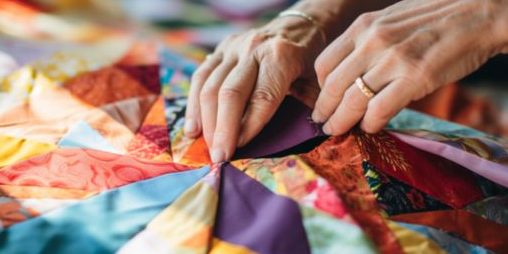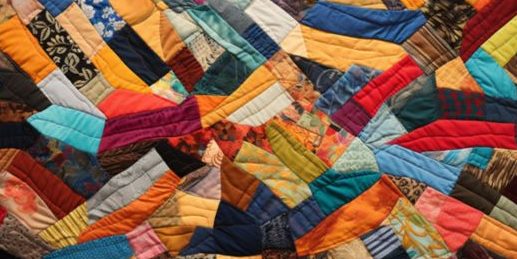Gather your friends and family for a fun and creative project – quilt-making!
Group projects in quilt-making can be a great way to bond with the people you care about while creating something beautiful.

Learn how to choose a pattern, gather supplies, and make the most of your time together.
Get ready to make some amazing quilts together!
Benefits of Group Projects in Quilt-Making
Clearly, there are many benefits to engaging in group projects in quilt-making.
For one, it allows for the sharing of ideas between multiple people. This is beneficial for those who may be new to quilt-making, as they can gain tips and advice from more experienced quilters. Working in a group also gives everyone the opportunity to contribute their own unique skills and perspectives to the project, resulting in a more diverse and creative outcome.
Group projects also help with time management. When multiple people are working on the same project, tasks can be distributed and completed in a timely manner. This helps to ensure that the project is completed on schedule and to the best of its potential. Additionally, it helps to reduce stress and anxiety, as everyone knows that their tasks are being taken care of and that the project will be finished on time.
Group projects in quilt-making also provide an opportunity for socialization. It can be a great way to bond with friends and family, as everyone works together towards a common goal. It’s also an ideal way to meet new friends who share the same interests. Quilting can also be a fun and creative activity that can bring people together.
Choosing a Group Project Pattern
When choosing a group project pattern for quilt-making, you and your team need to consider a few key factors:
- Selecting fabric: Before you start picking out a pattern, determine the type of fabric you’ll be using for the project. Consider the project’s purpose and the desired look and feel of the quilt.
- Assessing skill level: Make sure you’re realistic about the skill level of the group and choose a pattern that’s within everyone’s ability. Don’t choose something too complicated that will be difficult to complete.
- Time: Once you have chosen a pattern, assess how much time is needed to complete it, and make sure that you all have the time to devote to the project.
- Sharing the workload: Make sure that the workload of the project is shared fairly and that everyone feels they’re making a valuable contribution.
These are the key factors to consider when choosing a group project pattern for quilt-making. Make sure to take your time and be thorough in your selection process. With a little bit of planning and some thought, you and your team can create a beautiful quilt that you can all be proud of.
Supplies for Group Quilt-Making

Frequently, and with careful planning, you’ll need to gather the necessary supplies for your group quilt-making project.
This can include fabric, batting, thread, needles, and other items necessary to complete the project. Depending on the size of the group, you may want to consider having each person bring their own supplies or sharing supplies between members.
| Advantage | Disadvantage |
|---|---|
| Sharing supplies saves money | Risk of losing or breaking items |
| Easier to plan for exact materials needed | Possibility of disagreements among group members |
When it comes to sharing supplies, it’s important to have clear communication between group members. Set up a plan for how the supplies will be shared and when they need to be returned. This will help ensure that everyone gets the materials they need. Also, consider creating a check-out system so that each person is responsible for the items they are borrowing.
Finally, it’s important to keep track of the supplies throughout the project. Be sure to mark each supply with the name of the person borrowing it so that it can be returned to the proper person. This will help you be organized and ensure that everyone is getting the supplies they need.
Tips for Successful Group Quilt-Making
To ensure success in your group quilt-making project, here are some tips you can follow:
These tips will help ensure your group quilt-making project is successful. With clear roles and a plan in place, you can make use of time-saving tools and have fun socializing with the other members of your group.
Making the Most of Quilt-Making Group Projects

Your group’s quilt-making project can be even more successful if you make the most of it. To ensure this, start by sharing resources. Everyone in the group should be able to access the same materials and tools. Consider giving each member their own fabric and colors to use, or pool resources so everyone has access to the same supplies.
Next, divide tasks. It’s important to assign each member a specific role to ensure the project is completed on time. This doesn’t mean each person has to do the same thing; assign each member tasks that they are comfortable with or tasks that highlight their strengths.
Finally, be open to everyone’s ideas. Quilt-making is a creative process and everyone’s perspective should be taken into account. Ask for feedback and suggestions and be open to trying different techniques.
| Sharing Resources | Dividing Tasks | Being Open to Ideas |
|---|---|---|
| Everyone has access to the same materials and tools | Assign each member a specific role | Ask for feedback and suggestions |
| Give each member their own fabric and colors | Assign tasks that each member is comfortable with | Be open to trying different techniques |
| Pool resources so everyone has access to the same supplies | Assign tasks that highlight each member’s strengths | Consider everyone’s ideas |
Frequently Asked Questions [FAQs]
How Much Time Is Typically Required for Group Quilt-Making Projects?
Cooperative strategies and group dynamics can greatly influence how much time it takes to complete a project. It typically depends on the size, complexity, and skills of the group.
How Do You Handle Disagreements Among Group Members?
When disagreements arise, it’s important to use conflict resolution techniques and communication styles that foster understanding and respect.
What Is the Best Way to Divide up Tasks Among Group Members?
Discuss the best way to divide up tasks by sharing responsibilities and working collaboratively. Agree on tasks that are best suited for each person’s skills and interests, and make sure everyone feels equally invested in the project.
What Are the Best Ways to Store Group Quilt-Making Supplies?
You want to keep your supplies organized and fabrics separate? Try labeled boxes or bins, and store the fabric rolls in a safe place. Grouping like items together will make selection and organization easier.
What Are the Best Ways to Document Group Progress on Quilt-Making Projects?
Document group progress by taking advantage of team dynamics and communication strategies. Utilize checklists, meeting notes, and photos to track progress.
Conclusion
Group projects in quilt-making can be a fun and rewarding experience for all participants. With the right supplies, pattern, and tips, you can make the most of your group project and create something beautiful that will last for years to come.
So don’t delay, gather your friends and family and start a quilt-making project today!




Leave a Reply